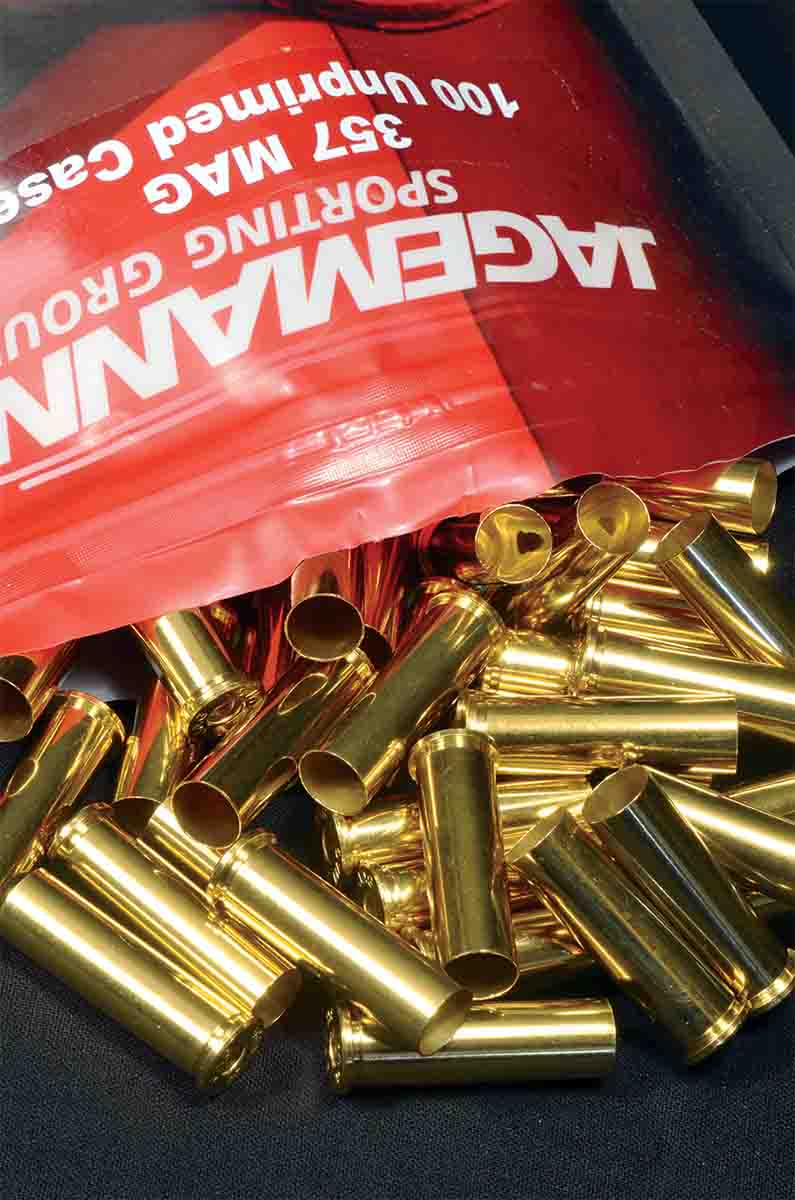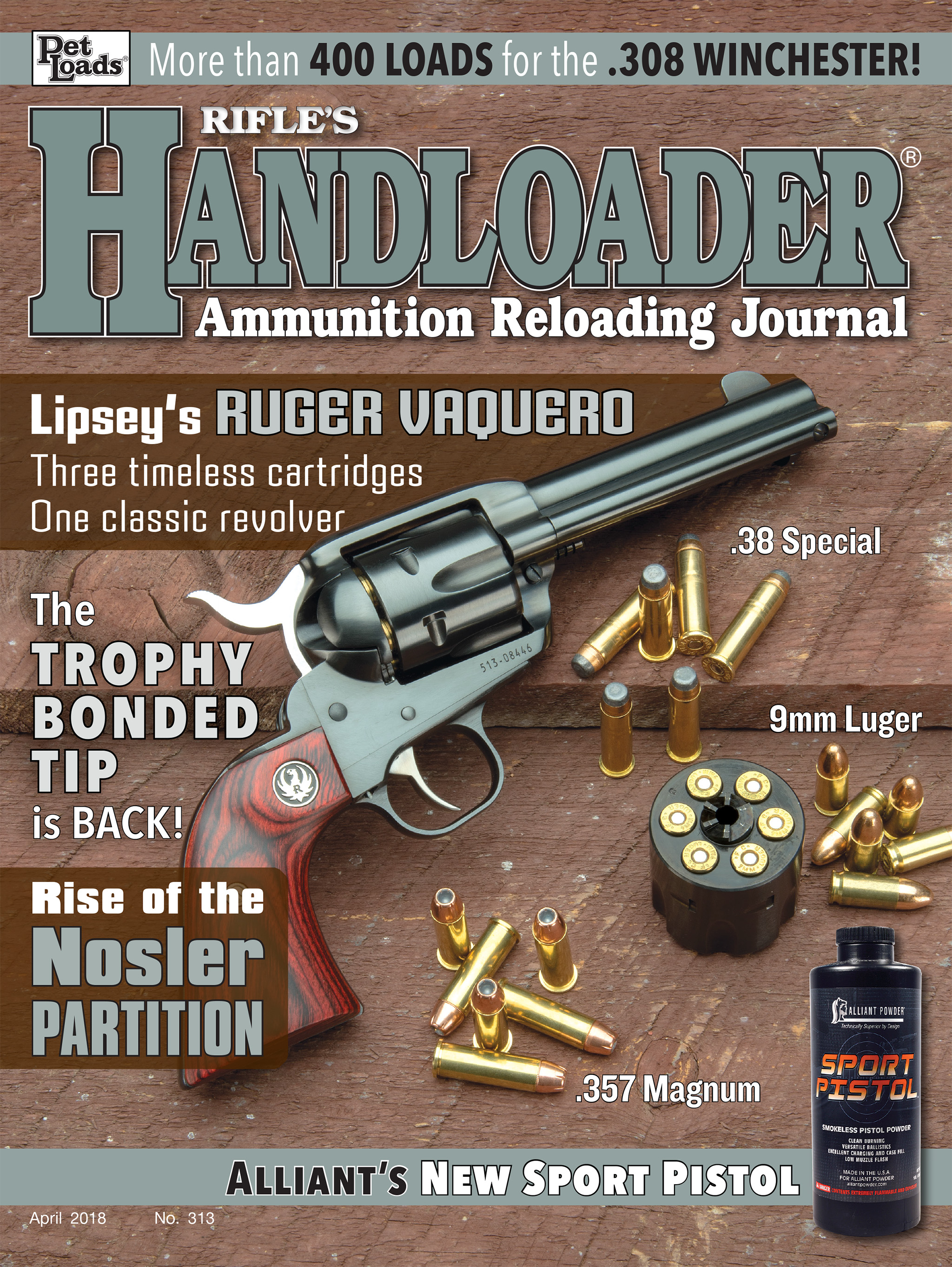In Range
The Thorny Business of Brass
column By: Terry Wieland | April, 18
People in this business set great store by product testing. By “people,” I include readers, writers, editors, advertising salesmen and, not least of all, manufacturers. There are many pitfalls connected with this practice. Not the least is the fact that almost all testing is done without any real standards or guidelines.
In the case of brass and bullets, the problem is magnified by the fact that, generally speaking, bullets are proven good or

Provided the bullet and primer seat properly, and the cartridge can be chambered and ejected with no difficulty, about the only real test of brass quality is sheer longevity and the number of times it can be reloaded without the primer pocket expanding or the case mouth splitting. Even that is not absolute, since repeated resizing work-hardens the brass. You then get into the question of how many times it can be reloaded without annealing the neck. At that point, there are too many variables at play to draw any firm or fair conclusions.
Overall, the quality of brass available today is miles ahead of the average brass of years ago. This is partly a result of handloading and pressure on manufacturers to deliver brass that can be fired more than one time without giving up the ghost. It is also partly a result of competition.
Back in the 1960s, to the best of my recollection and ability to research, there were a half-dozen independent bullet makers, but not a single maker of virgin brass. Today there are at least a dozen actual manufacturers of brass, and a few more companies that have brass made for them and then market it under their own name. In the case of the latter, if the manufacturer’s quality slips, it will have the wrath of its corporate customer raining down, all of which contributes to a high standard.
The first independent brass maker that I recall being aware of was Dr. Jim Bell, proprietor of Brass Extrusion Laboratories, Ltd. (B.E.L.L.), which was nothing if not a clever linguistic play. B.E.L.L. brass came along in the 1980s and provided the wherewithal for several generations of British double rifles and old American single-shots to start booming once more. Around the same time, or a little earlier, A-Square started up and provided brass for a number of cartridges that even Jim Bell was not prepared to accommodate.
After that, I lost track. Starline started production in Sedalia, Missouri, as an offshoot of Sierra Bullets. Quality Cartridge went into business on the East Coast. When Jim Bell retired and sold out, much of his machinery went to Jamison Industries in Sturgis, South Dakota, which has produced brass in fits and starts.
In Australia, Bruce Bertram had begun producing brass long before, to supply the nitro-express rifles that were becoming cult objects there as a result of the influx of old rifles from India. Bertram brass was rare in the U.S. until a couple of importers began bringing it in. Bertram provides a good object lesson in the perils of product testing. Some .303 Savage brass I got from the company cracked on the first firing, seven rounds out of 10; some .500 Express (3¼), on the other hand, has been fired numerous times without a hitch, as has some .40-70 Straight Sharps. What does that prove? Some cases are good, some are not, and that is about all.
Logically, fledgling brass makers usually began by identifying an underserved part of the market and going after it. Starline specialized in handgun cases for various types of competition, and is now offering bottleneck brass. Quality Cartridge makes odd calibers, such as .450 Ackley, but is also prepared to produce wildcats, including some with the proper headstamp. B.E.L.L., as noted, cultivated the old black-powder and nitro-express market.
It seems to me that a good approach would be to find a couple of calibers that are not available from anyone else and fill that niche immediately. Then, if your brass is good, those buyers will go on to try some of your other, more common, calibers. Instead, from all appearances, new brass makers seem to plunge in and make exactly what everyone else is making. I cannot imagine that we really need more .45 ACP or .38 Special, or .223 Remington or .308 Winchester, but normally that’s the list. Why a manufacturer would feed its new product into the part of the market with the most supply, hence the most competition and therefore the slimmest margins, is beyond me, but then I don’t have an MBA or a marketing degree.
When I have asked brass makers about this, the usual answer is that they will start to make some of the less common calibers once they become established. This seems to me to be doing it in reverse of what is likely to work, but I’m not in the brass business.
Eight years of the Obama administration, with periodic threats of a Democratic (antigun) ascendancy, drove sales of both ammunition and brass, causing shortages in some areas. This encouraged importers to bring in products from Europe, notably Sellier & Bellot (S&B) in the Czech Republic, and PPU from Serbia. From my experience, both are very high quality, and they make calibers such as .30 Mauser and .30 Luger, which are available nowhere else. S&B used to make some match .32 S&W wadcutter loads that were excellent, and the brass reloaded like a dream. Unfortunately, I haven’t seen any of this in a while.
Whatever downside there is to globalization (and I am sure there are several), it has led to the greatest supply, combined with the greatest variety, of ammunition and brass in American history.
A new company in the brass business is Jagemann Sporting Group, of Manitowoc, Wisconsin. It is an offshoot of Jagemann Stamping Co., which began in the metal-stamping business in 1946. The company is still family owned, which is nice to see. New brass is not its only product, obviously. It has mainly been a supplier to the automotive industry, and today it makes a few pistol magazines as well. This is a natural for metal-stamping experts, obviously, but the company is also making magazines from polymer. Its corporate headquarters is in Manitowoc, while the plastic injection moulding operation is in Murfreesboro, Tennessee.
Last time I looked, Jagemann was offering cases for seven different rifle cartridges and 16 handgun cartridges. None are in particularly rare calibers, but some are at least borderline exotic, such as .357 SIG, .38 Super Comp, 5.56x45 NATO and .300 BLK.
What sets Jagemann apart from some other brass-making operations that have sprung up in the last 20 years is the fact that it is an existing company of proven expertise and performance, which has established brass making as a subsidiary product. It is not merely a guy with a garage, a dream, and a couple of machines. It is, therefore, likely to be in the business for the long haul.
The only Jagemann brass that I have used so far has been .38 Special, .44 Special, .44 Magnum and .45 Colt. All of it has been excellent right out of the bag and has been reloaded a few times with no hitches. If I encounter any problems in a year or two, I’ll get back to you.
* * *
In Handloader No. 311 (Dec/Jan 2017), I incorrectly referred to Hermann Gerlich as Harold Gerlich. His full name was Hermann Ernst Gustav Torismund Gerlich.


